Travel Log
HEADING TO MEXICO!
An Interesting stop....
Have you heard of Slab City? Neither had we until buying an rv. It's on the site of an abandoned Navy base in the desert near the Salton Sea, and there's no place like it in the whole country. When the Navy left after WWII, they removed all the buildings but left the concrete foundations and all the streets intact. At some point, people began taking up residence in their RVs, parking on the concrete slab foundations because they were level and offered an obvious territorial boundary. There is no water (or sewer), no electricity, no garbage pickup, no rent, no rules, no nothing. A few hardy souls live there year around, even in the blazing heat of summer, and others have been coming for years to spend the winter, arriving in October and staying through early Spring. When we visited it was late March, and there were about 300 RVs scattered throughout the area, some nice-looking newer rigs, some schoolbus conversions inspired by the '60's, and other rigs just barely holding together, that obviously would never leave. People drive a few miles into Niland, the nearest town, for supplies and water, and some to dump their garbage and wastewater tanks, but most seem to just dig a hole in the desert and run their sewer hoses into it. Garbage and ruined vehicles lay covered by dust in the desert shrubs. But there are also signs of community: a church, a small cafe, a library/video rental store, a flea market, a solar energy business, a "theatre" with regular live music and dances, and a daily CB radio program with the day's news and announcements. To Rus, Slab City looded like a post-Apocaliptic retirement community, but it also has a certain appeal, a place where you can just be free to be whoever you are, as long as you don't bother anyone else. We're glad there's a place like that left on the planet, and also glad we don't live there. Before leaving, we bathed in the "shower", an irrigation pipe draining into a drop inlet, an old truck mirror fastened to the concrete wall to shave by, with a rusted folding chair nearby on a scrap of carpet for a dressing room. People swear it's clean water, and it refreshed us from the mid-day desert oven heat.
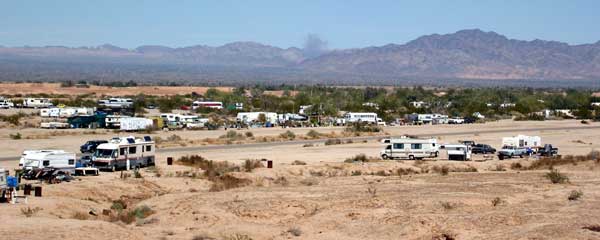
Slab "City" and nearby Navy bombing range.
MEXICO!
Crossing the Border er
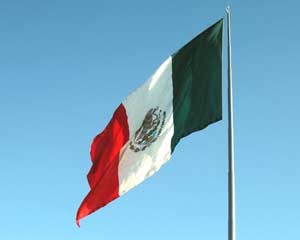 After a wonderful visit with Rus's parents, Marge and Les, we were ready to cross into Mexico. We didn't want to face Tijuana, the busiest crossing on the U.S/Mexico border. We'd done it before, but still feeling the peace and solitude of the desert, we didn't want Tijuana to be our first experience in Mexico. Instead we drove east, camped for the night, and crossed at Tecate the next morning. The officials there were friendly and helpful, and we saw only one other tourist couple, in Migracion, where you get your tourist cards. Tecate is a beautiful hillside city with a lovely plaza, the best Mexican bakery we've seen, and a brewery that employs around a thousand people. Rus had never cared much for Tecate beer, but found out the export version is toned down for American tastes. In Mexico, Tecate is brighter and hoppier, best in bottles but harder to find. We headed down Mexico 3 and found a nice place to camp next to a mostly abandoned hotel near Estero Beach, south of Ensenada. For dinner we ate more of the tamales we bought in Tecate and watched the sun set while talking to our kids, knowing Verizon service would be scarce from here on. We'd made it to Mexico! After a wonderful visit with Rus's parents, Marge and Les, we were ready to cross into Mexico. We didn't want to face Tijuana, the busiest crossing on the U.S/Mexico border. We'd done it before, but still feeling the peace and solitude of the desert, we didn't want Tijuana to be our first experience in Mexico. Instead we drove east, camped for the night, and crossed at Tecate the next morning. The officials there were friendly and helpful, and we saw only one other tourist couple, in Migracion, where you get your tourist cards. Tecate is a beautiful hillside city with a lovely plaza, the best Mexican bakery we've seen, and a brewery that employs around a thousand people. Rus had never cared much for Tecate beer, but found out the export version is toned down for American tastes. In Mexico, Tecate is brighter and hoppier, best in bottles but harder to find. We headed down Mexico 3 and found a nice place to camp next to a mostly abandoned hotel near Estero Beach, south of Ensenada. For dinner we ate more of the tamales we bought in Tecate and watched the sun set while talking to our kids, knowing Verizon service would be scarce from here on. We'd made it to Mexico!

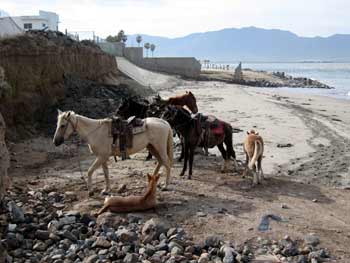 In the morning we were witness to a tragic event. Right next to our camp a young colt was following its mother and some other horses down a path to the beach, slipped and fell, apparently striking its back on a rock, paralyzing its hindquarters. It wasn't in pain, but could not get on its feet. We felt very bad for the colt and for its owners, who were obviously very poor and facing a considerable financial loss as well as an emotional one. They tried repeatedly to make it walk, but it's legs just collapsed. We helped them, a man and two boys, carry the colt to the bed of an old pickup, and wished for its recovery, however slim the possibility, as they drove away. In the morning we were witness to a tragic event. Right next to our camp a young colt was following its mother and some other horses down a path to the beach, slipped and fell, apparently striking its back on a rock, paralyzing its hindquarters. It wasn't in pain, but could not get on its feet. We felt very bad for the colt and for its owners, who were obviously very poor and facing a considerable financial loss as well as an emotional one. They tried repeatedly to make it walk, but it's legs just collapsed. We helped them, a man and two boys, carry the colt to the bed of an old pickup, and wished for its recovery, however slim the possibility, as they drove away.
Next stop was a place we'd been to years before, Bahia San Quintin on the Pacific Coast. We motorbiked around the trails nearby, then over to the restaurant, Cielito Lindo's, where we feasted on delicious grilled stone crab claws smothered in butter, garlic, and paprika, called jaiba. Kathleen had never forgotten eating this local delicacy. This time it was almost as good as she remembered, and well worth the effort and greasy fingers. The best part of the dinner, though, was the Mariachi band, singing mostly for a local couple celebrating their anniversary, and looking very much in love.
Bahia San Quintin is a huge windswept bay, bordered by ancient volcanos, dunes, marshlands and farmlands. Black brant (a small goose) from the Aleutians stop during their migration to feed on the eelgrass, attracting hundreds of gringo hunters each year. Fortunately it wasn't hunting season, so we had the place pretty much to ourselves at Gypsy's where we camped. Last time we'd visited, the season was on and the hotel nearby was full, Weber grills outside every room with guys still in their camo outfits barbequeing their brant and swapping stories.
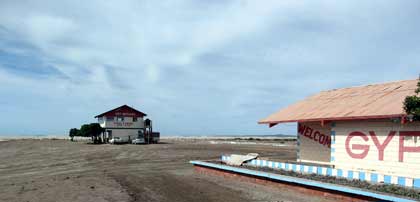
Gypsy's camp and the Wet Buzzard
(Zopillote Mojado)
On down Mexico 1 through an amazing desert garden like none other on the planet, the varities and abundance of cactus get ever more impressive and delightful, especially to a plant-lover like Kathleen. The cirio (Spanish name for candle) is a tall, gangly looking plant that begins to dominate the horizon at a certain point, and several hundred miles later disappears just as suddenly. It turns out that cirio only grow in a narrow band between the 30th and 27th parrallels on Baja and there are some in Sonora, Mexico at the same latitude. They grow to 50 feet high but only a little over an inch a year!! We felt fortunate to see them in bloom, like a little flame at the tip of the (candle) branch.
Cirios, also called Boojum trees
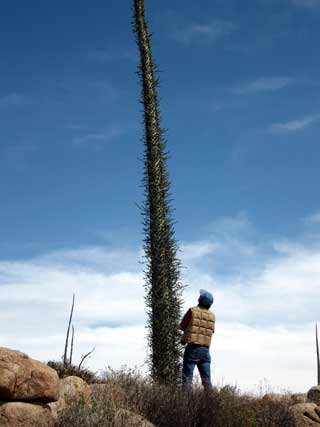 |
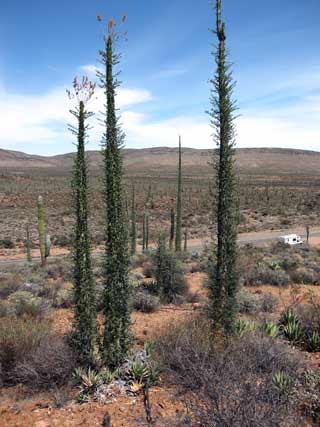 |
We found a dirt road leading into the Catavina Boulder Fields to hike and stop for lunch. This area is protected as a Natural Park by the Mexican Government. The land is striking in an earie way, strewn with boulders and odd plants that have adapted to the arid conditions in a variety of unusual manners. Elephant trees, the tall cardon cacti, barrel cacti, cholla, mesquite, yucca and many others live and appear to thrive in this rockbed of dusty soil. We theorized that the boulders may act as a mulch that preserves moisture. We drove away with a visual image of these vast boulder fields etched into our minds forever.

Catavina Boulders
It was a long day but we made it to Guerrero Negro just as night was falling, having crossed into Baja California Sur, a different state, where we reluctantly surrendered all of the fruit we'd just bought and had our vehicle sprayed with insecticide, for a fee, of course. (It turned out they only sprayed the tires and were done before Kathleen finished closing the vent. It cost $20, pesos, that is.) We found a comfortable berth at the Malarrimo, which also had a very fine restaurant where we feasted on the seafood Baja is famous for. From our camp we had a view of the back of the kitchen, and the next morning we watched with great interest the purchase of fish for the day's business. Everyone seemed to be involved in the decision of what to buy, from the owner, the chef, and down to the waiters who'd served us the night before. Much inspection and discussion preceeded each purchase, with individual cash payments for each type of fish bought. The entire transaction took well over an hour, and involved at least half a dozen purchases, all from the same vendor. In the U.S., the wholesaler would simply drop off what the chef had phoned or faxed in, and put it on the restaurant's monthly account. Might take 2-3 minutes. A lot of time would be saved, and a lot would be lost in the process.
 We took a drive out to see the joint Mexican/Japanese saltworks at Guerrero Negro, a huge complex of evaporation ponds where the salt crystalizes, then is scooped up and barged 80 km away to Isla Cedros where there is a port deep enough to service the ships that deliver it to other North America and Japanese ports. The shallow port has been a problem for other ventures besides Exportadora Sal; Guerrero Negro (black warrior) is named for a Hawaiian whaling ship that in 1858 was so overloaded with whale oil it couldn't make it out of the lagoon and sank. It may have been the first oil spill in the New World! Though the whales at the famous Ojo de Liebre Lagoon had moved on two weeks before our visit, we enjoyed a long hike along its deserted shores, watching the tide sweep into the flats. There we discovered a whale barnacle (we think) and a deserted tortouse shell. We took a drive out to see the joint Mexican/Japanese saltworks at Guerrero Negro, a huge complex of evaporation ponds where the salt crystalizes, then is scooped up and barged 80 km away to Isla Cedros where there is a port deep enough to service the ships that deliver it to other North America and Japanese ports. The shallow port has been a problem for other ventures besides Exportadora Sal; Guerrero Negro (black warrior) is named for a Hawaiian whaling ship that in 1858 was so overloaded with whale oil it couldn't make it out of the lagoon and sank. It may have been the first oil spill in the New World! Though the whales at the famous Ojo de Liebre Lagoon had moved on two weeks before our visit, we enjoyed a long hike along its deserted shores, watching the tide sweep into the flats. There we discovered a whale barnacle (we think) and a deserted tortouse shell.
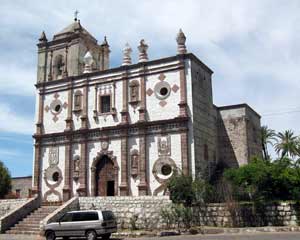 Moving away from the Pacific side of Baja, we next came to the lovely town of San Ignacio, with its 1786 mission dominating a square completely shaded by huge old trees. Rus had visited there in 1974, and revisiting now, finally found a place that time forgot. We stayed a few nights, parked under a date grove next to a freshwater lagoon, where we swam to escape the afternoon heat. In the evenings we walked into town to enjoy the "night-life", which consisted of families and friends gathering and chatting on the square, small children playing nearby, teenagers crowding into the internet cafe, and a few vendors doing pretty good business selling stuff far too sweet for our tastes. The dates San Ignacio was famous for are no longer much of an Moving away from the Pacific side of Baja, we next came to the lovely town of San Ignacio, with its 1786 mission dominating a square completely shaded by huge old trees. Rus had visited there in 1974, and revisiting now, finally found a place that time forgot. We stayed a few nights, parked under a date grove next to a freshwater lagoon, where we swam to escape the afternoon heat. In the evenings we walked into town to enjoy the "night-life", which consisted of families and friends gathering and chatting on the square, small children playing nearby, teenagers crowding into the internet cafe, and a few vendors doing pretty good business selling stuff far too sweet for our tastes. The dates San Ignacio was famous for are no longer much of an  economy; in fact the groves look neglected and the fruit just falls on the ground to rot or be eaten by birds. They're delicious; not the sticky, oversweet dates we see in the States, but drier, nuttier, and very high in protein (sounds crazy, but the book said so). At our little camp under the date grove, we met several Canadians who were on their way home after spending the winter months camped on a beach, looking very tanned and rested. We'd been meeting other Canadians recently, all on their way home. Why were they all leaving at the same time? It turns out that they had to be home to pay their taxes by April 30, and were waiting until the last minute, just like Americans do. Our Canadian friends were generous with information about Baja that they'd gathered over many years. Only after 2 or 3 margaritas, though, did they disclose the route to their top secret free camping spot. economy; in fact the groves look neglected and the fruit just falls on the ground to rot or be eaten by birds. They're delicious; not the sticky, oversweet dates we see in the States, but drier, nuttier, and very high in protein (sounds crazy, but the book said so). At our little camp under the date grove, we met several Canadians who were on their way home after spending the winter months camped on a beach, looking very tanned and rested. We'd been meeting other Canadians recently, all on their way home. Why were they all leaving at the same time? It turns out that they had to be home to pay their taxes by April 30, and were waiting until the last minute, just like Americans do. Our Canadian friends were generous with information about Baja that they'd gathered over many years. Only after 2 or 3 margaritas, though, did they disclose the route to their top secret free camping spot.
Photo at right: dates growing
Speaking of dogs....
 One of the Canadians had just the day before adopted a stray dog that had been hanging out on their beach. It was terrified of going into their vehicle, but was obviously warming to the attentions of its new master. It was typical of many of the dogs we were seeing here: medium size, short brown coat, erect ears, alert expression, about a year old (you don't see dogs past a few years old here). People are jokingly referring to this type in Baja as a distinct breed, the Peninsular Hound. On this trip so far, we've seen four people adopt Mexican dogs. All that's necessary is a rabies shot and proof of vaccination, and the dog is yours. Costs about $8 in Mexico. Mexican dogs are a constant source of conversation among non-Mexicans visiting the country. First of all, there are dogs everywhere, especially in the small towns and rural areas. There are also dead dogs everywhere on the roadside, and no-one bothers to pick them up, it seems. If the dog is killed too close to someone's home, they'll sprinkle lime on it to keep the smell down until the carcass One of the Canadians had just the day before adopted a stray dog that had been hanging out on their beach. It was terrified of going into their vehicle, but was obviously warming to the attentions of its new master. It was typical of many of the dogs we were seeing here: medium size, short brown coat, erect ears, alert expression, about a year old (you don't see dogs past a few years old here). People are jokingly referring to this type in Baja as a distinct breed, the Peninsular Hound. On this trip so far, we've seen four people adopt Mexican dogs. All that's necessary is a rabies shot and proof of vaccination, and the dog is yours. Costs about $8 in Mexico. Mexican dogs are a constant source of conversation among non-Mexicans visiting the country. First of all, there are dogs everywhere, especially in the small towns and rural areas. There are also dead dogs everywhere on the roadside, and no-one bothers to pick them up, it seems. If the dog is killed too close to someone's home, they'll sprinkle lime on it to keep the smell down until the carcass  dries up, like ranchers used to do with dead livestock in the U.S. The other day we saw a dog in Mazatlan with a broken rear leg attached by only a scrap of skin. The dog obviously belonged to a street vendor. Now when we say "belonged" we don't mean to imply the same attachment or responsibilities of ownership that term would mean in the U.S. Here, it may only mean a loose connection with no responsibilities, especially financial ones. There are dogs in Mexico that are as much pampered pets and members of the family as they are back home, but it seems the exception. A lot of people are afraid of dogs, too, especially big black ones like Ziggy; so she's getting more respect here than she ever had at home! Grown men will pat their hearts rapidly and open their eyes wide as if in fright, point to her, and move away. dries up, like ranchers used to do with dead livestock in the U.S. The other day we saw a dog in Mazatlan with a broken rear leg attached by only a scrap of skin. The dog obviously belonged to a street vendor. Now when we say "belonged" we don't mean to imply the same attachment or responsibilities of ownership that term would mean in the U.S. Here, it may only mean a loose connection with no responsibilities, especially financial ones. There are dogs in Mexico that are as much pampered pets and members of the family as they are back home, but it seems the exception. A lot of people are afraid of dogs, too, especially big black ones like Ziggy; so she's getting more respect here than she ever had at home! Grown men will pat their hearts rapidly and open their eyes wide as if in fright, point to her, and move away.
To the Sea of Cortez
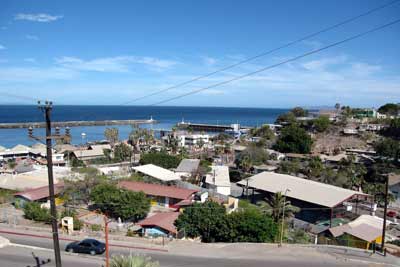 Next on our itinerary, such as it is, was Santa Rosalia, a place more interesting for what it was than for what it is. It used to be a big copper mining town, from the late 1800's to the 1950's when the ore ran out. The French developed the resource and built many of the downtown buildings out of lumber imported from the Pacific Northwest, where the smelted ore was shipped for refining. The town still has a French Colonial feel to it, slightly reminiscent of the Vieux Carre in New Orleans. It twists the mind a bit to wander the streets and hear Spanish spoken. For some reason it's the gay capital of Baja California; Rus remembers many years ago being surprised to see an openly gay man in drag outside a restaurant there, so apparently it's not a new thing. Santa Rosalia also used to be the terminus for the ferry running to Guaymas, which we are told is no longer running. We're also told it's running again. Take your pick. And one more thing: Santa Rosalia's Iglesia Santa Barbara was designed and built by the same guy who did the Eiffel Tower, the Panama Canal locks, and the Statue of Liberty frame: that's right, Alexandre Gustgave Eiffel. It was built to show at the 1889 Paris World Exposition along with the Eiffel Tower, took first prize, then was dismantled and put into storage. One of the French copper barons bought it a few years later and had it reassembled in Santa Rosalia where it stands today, still in great shape. Next on our itinerary, such as it is, was Santa Rosalia, a place more interesting for what it was than for what it is. It used to be a big copper mining town, from the late 1800's to the 1950's when the ore ran out. The French developed the resource and built many of the downtown buildings out of lumber imported from the Pacific Northwest, where the smelted ore was shipped for refining. The town still has a French Colonial feel to it, slightly reminiscent of the Vieux Carre in New Orleans. It twists the mind a bit to wander the streets and hear Spanish spoken. For some reason it's the gay capital of Baja California; Rus remembers many years ago being surprised to see an openly gay man in drag outside a restaurant there, so apparently it's not a new thing. Santa Rosalia also used to be the terminus for the ferry running to Guaymas, which we are told is no longer running. We're also told it's running again. Take your pick. And one more thing: Santa Rosalia's Iglesia Santa Barbara was designed and built by the same guy who did the Eiffel Tower, the Panama Canal locks, and the Statue of Liberty frame: that's right, Alexandre Gustgave Eiffel. It was built to show at the 1889 Paris World Exposition along with the Eiffel Tower, took first prize, then was dismantled and put into storage. One of the French copper barons bought it a few years later and had it reassembled in Santa Rosalia where it stands today, still in great shape.
Morning fishing, and view from camp at Caleta San Lucas
 |
 |
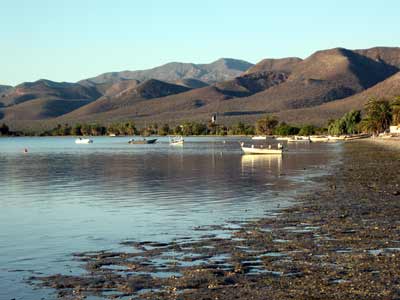 We landed that night in a fish camp called Caleta San Lucas, the only ones in our area except for some big reefer units filled with something that smelled really bad, but fortunately we were upwind of them, and it was windy. This was a funky place, but suited us just fine. It even had hot showers: all you had to do was open the valve on the rusty propane tank out behind the banos, light the water heater and wait awhile, and there's your hot shower! Another rig pulled up before long, found a parking place, and after a few minutes a couple exited holding martinis in actual martini glasses, looking just fabulous. We were spellbound to see such a couple in such a place, and eagerly accepted their invitation to have a drink with them, sangria no less, as they were out of gin. We landed that night in a fish camp called Caleta San Lucas, the only ones in our area except for some big reefer units filled with something that smelled really bad, but fortunately we were upwind of them, and it was windy. This was a funky place, but suited us just fine. It even had hot showers: all you had to do was open the valve on the rusty propane tank out behind the banos, light the water heater and wait awhile, and there's your hot shower! Another rig pulled up before long, found a parking place, and after a few minutes a couple exited holding martinis in actual martini glasses, looking just fabulous. We were spellbound to see such a couple in such a place, and eagerly accepted their invitation to have a drink with them, sangria no less, as they were out of gin.  Dave and Jocelyn have been on the road over a year now, all over the U.S. and Canada, and now Mexico. Dave is an attorney currently specializing in personal freedom and travel, and Jocelyn is an accomplished artist. Next day we invited them to go clamming with us, something none of us knew anything about, but the past few days we'd seen people digging their feet into the sand in the shallow water offshore. Occasionally they'd reach down and stuff something into a bag, and we figured it had to be clams. We waited for low tide, when clams are supposed to be least happy, waded out into the shallows and began wiggling our feet in the sand. Amazingly, we were successful, though it took us a while, and fortunately Jocelyn is allergic to seafood so we didn't have to get quite so many. We steamed them in white wine, garlic, butter and parsley, and they were about the best we'd ever had. We ate and laughed and sang songs (Dave also plays guitar) until way past our bedtimes. Dave and Jocelyn have been on the road over a year now, all over the U.S. and Canada, and now Mexico. Dave is an attorney currently specializing in personal freedom and travel, and Jocelyn is an accomplished artist. Next day we invited them to go clamming with us, something none of us knew anything about, but the past few days we'd seen people digging their feet into the sand in the shallow water offshore. Occasionally they'd reach down and stuff something into a bag, and we figured it had to be clams. We waited for low tide, when clams are supposed to be least happy, waded out into the shallows and began wiggling our feet in the sand. Amazingly, we were successful, though it took us a while, and fortunately Jocelyn is allergic to seafood so we didn't have to get quite so many. We steamed them in white wine, garlic, butter and parsley, and they were about the best we'd ever had. We ate and laughed and sang songs (Dave also plays guitar) until way past our bedtimes.

...To be continued....
|

